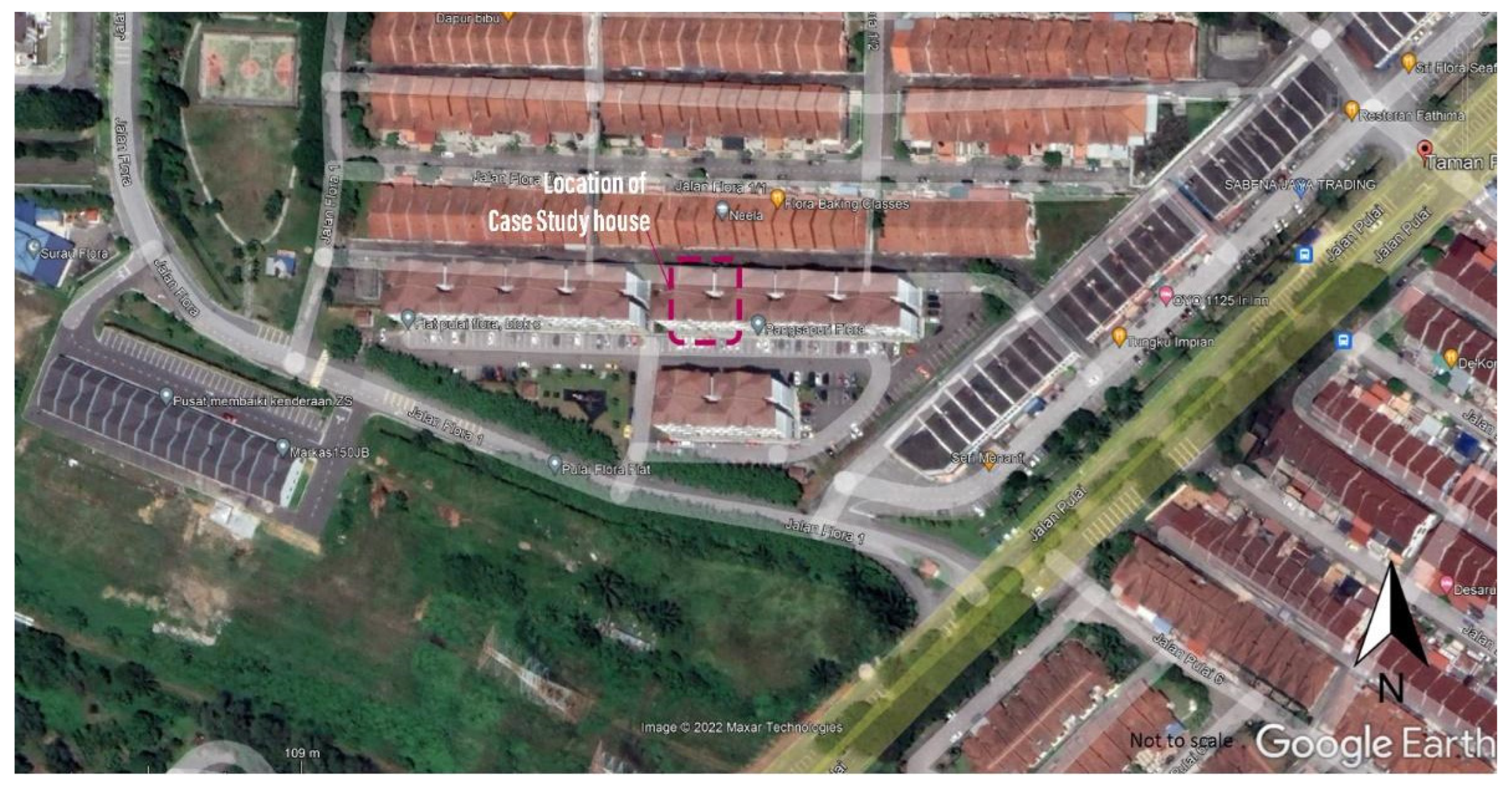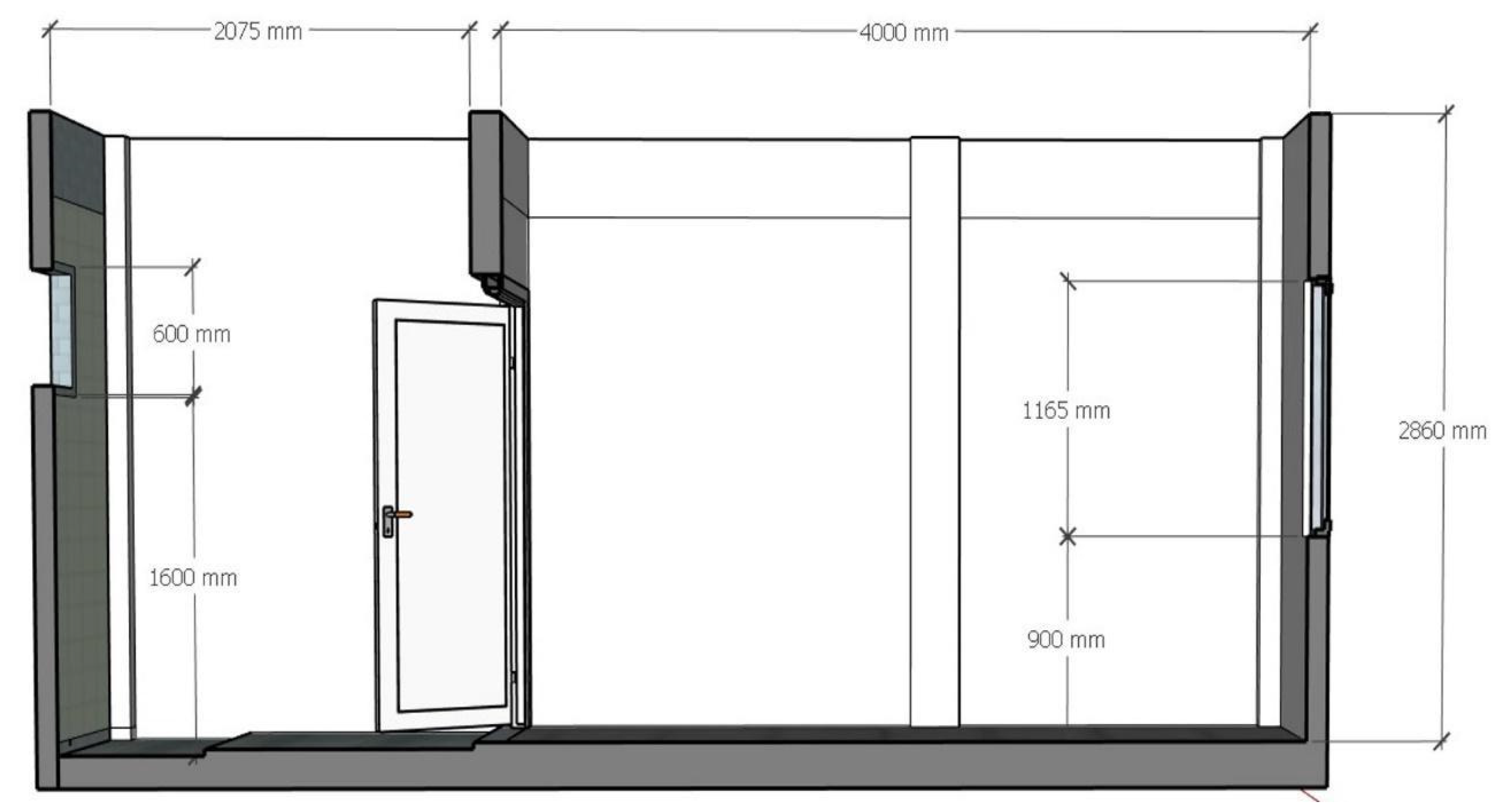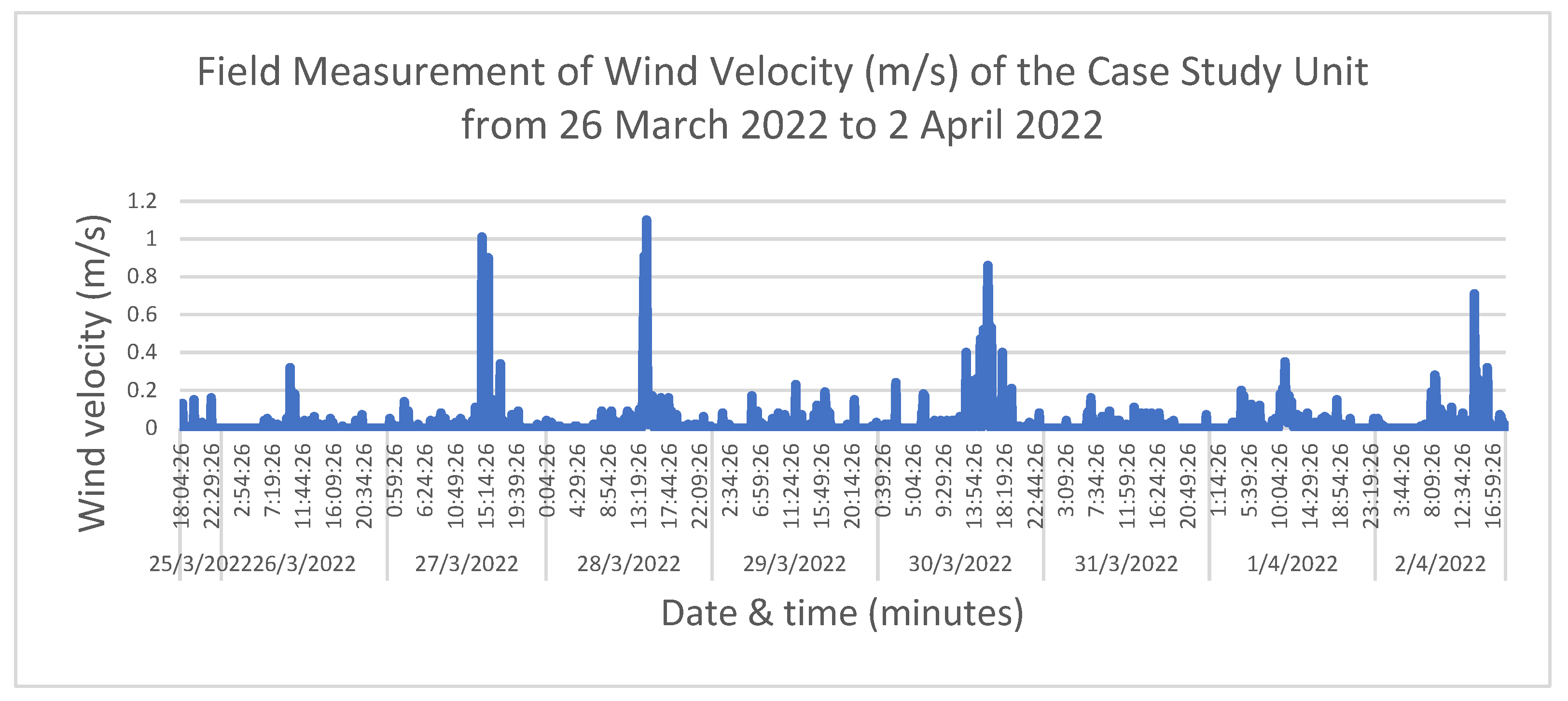1. Introduction
The Spanish flu pandemic in 1918 and, more recently, the global COVID-19 pandemic, serve to highlight the importance of air circulation for the mitigation of airborne contagious diseases—especially in high-density living environments. The inflow of fresh, outdoor air helps to minimise the accumulation of virus particles in indoor spaces [
1]. Epidemiological data show a much higher incidence of COVID-19 in developed European countries—such as Slovenia—and North American countries during the autumn and winter seasons than in African or Asian countries, which have milder climates that allow people to spend more time outdoors, where airborne spread is less significant [
2].
According to the World Health Organization, airborne viruses spread in poorly ventilated or crowded indoor spaces, as aerosols can remain airborne and travel within such confined settings. As modern building façades use more glazing and fixed glass panels, indoor air circulation is assisted by heating, ventilation, and air conditioning (HVAC) systems or air conditioning mechanical ventilation (ACMV) systems in countries that do not require heating [
3].
Despite the acknowledgement of the importance of good air circulation, there are limited references for specific ventilation and filtration targets beyond a need to increase the air-exchange rate, especially in multi-storey buildings in the tropics [
4,
5]. This paper assesses the current ventilation performance of a multi-storey residential building in Malaysia and, through virtual simulations, explores the effectiveness of the concept of a solar chimney to promote natural ventilation for the aforementioned building typology.
The American Society of Heating, Refrigerating, and Air-Conditioning Engineers (ASHRAE) has established ventilation guidelines for most interior environments [
6]. However, these guidelines are meant to achieve basic levels of acceptable indoor air quality, rather than passive infection control [
7]. This is achieved by encouraging the air-exchange rate in a space, commonly expressed in units of air changes per hour (ACH), although it can also be measured as total volumetric flow, volumetric flow per person and area, or outdoor air ventilation rates [
8].
The formula for calculating ACH is expressed as follows:
where ACH = air changes per hour, measured in cu.m/h; Q = volumetric flow rate, in cu.m/s, derived from air-flow velocity (m/s) × cross-sectional area (sqm); and Vol = the volume of the space, in cu.m.
Notwithstanding factors such as wind effect ventilation, buoyancy effect, and loss coefficient, which may affect the velocity of natural ventilation, an increase in air-flow velocity (measured in m/s) increases the volumetric flow rate in a fixed space which, in turn, increases the achievable ACH rate.
According to ASHRAE Standard 62.1-2019, a single-family home with three bedrooms, a default occupancy of 213.77 m
2 (2301 sqft), and 2.4 m (8 ft) spatial height is recommended to have an ACH rate of at least 4.0–6.0 ACH, or 0.32–0.35 ACH per person [
6,
8]. Fisk [
9] highlighted the effectiveness of higher ACH rates as an infection control mechanism, in line with ASHRAE’s minimum ACH recommendations for public buildings such as hospitals, at almost 10 times more than the recommendations for residential use.
In Malaysia, the ACH recommendations in the Third Schedule of the Uniform Building By-Laws 1986 (Amendment 2012) (UBBL) are concerned primarily with fresh air ventilation in spaces that are windowless and without access to external walls or fenestrations. Such habitable rooms should have a minimum fresh air change rate of 0.28 cmm, or 16.8 cmh per person, while bathrooms and toilets should have either 0.61 cmm per square metre or 10 ACH (whichever is lower) [
10]. The UBBL do not include ACH recommendations for naturally ventilated spaces.
There are several passive strategies to promote natural ventilation in indoor environments, including atria, courtyards, and solar chimneys, the latter of which are the focus of this paper. Solar chimneys are typically utilised on southwest- and south-facing buildings for the purposes of ventilation, heat insulation, and/or heat preservation, depending on the underlying intent of the designer. A solar chimney uses the thermal pressure differentiation between indoor and outdoor spaces to generate natural airflow [
11]. When the external wall of the solar chimney is heated by the sun, the air density within the solar chimney drops. Air is sucked up through a low opening on the internal wall and expelled from an opening high on the external wall.
Various studies have been conducted to determine the efficiency of the Trombe wall—a type of solar chimney—using field measurements or software simulations [
12,
13]. This includes research by Du et al., who studied the effectiveness of the Trombe wall by integrating mathematics and modelling to predict, derive, and examine patterns of air velocity [
11]. Solar chimneys drive airflow through thermal buoyancy; by maximising solar gain on its external façade, the chimney acts as a thermo-syphoning air channel to draw indoor air out of the building [
14].
However, while solar chimneys have been relatively well researched in Western countries, research on their effectiveness in tropical climates is still nascent. Previous studies on solar chimneys have tended to focus on industrial buildings, singular buildings such as residential homes, or large public buildings [
15,
16]. Tan and Wong [
15] determined that a solar chimney was able to naturally improve interior air speed and expedite changes in air temperature when tested in a single-storey classroom in Singapore. Hassanein and Abdel-Fadeel [
17] found that the use of multiple solar chimneys, oriented in different directions, further improves air-flow rates and reduces indoor temperatures, although their effectiveness is greatest when directly facing the sun. A quicker passive reduction in indoor temperature reduces the need and the time required for cooling demand. Furthermore, Gong et al. [
18] determined that users in tropical climates can accept air velocity rates ranging from 0.3 m/s to 0.9 m/s, while Roghanchi et al. [
19] ascertained that 1.0–2.0 m/s is ideal for thermal comfort.
This paper therefore focuses on two research gaps in solar chimney studies: their effectiveness in improving interior air speed and circulation in tropical climates, and their application in multi-storey public housing, where the addition of such a substantial element may incur critical cost implications.
Firstly, we propose that solar chimneys can be an effective passive method to improve natural ventilation in tropical buildings. By achieving the above objective, the findings of this study are not only beneficial from an architectural standpoint, but also advantageous for future health policies, as improved fresh outdoor air circulation in multi-storey housing may potentially slow down the spread of airborne contagious diseases.
The remainder of the paper is structured as follows:
Section 2 presents the methodology covering field measurements, coupled with validation of the Energy2D software, followed by a simulation of four scenarios;
Section 3 presents the results and discussions of the simulated scenarios; finally,
Section 4 provides our conclusions and recommendations.
As a passive method to accelerate ACH, increase fresh air inflow, and displace airborne contaminants, it is hoped that a more widespread acknowledgement and adoption of this strategy may limit the impact of future airborne diseases, such as the SARS-CoV-2 virus.
3. Results and Discussion: Scenario Simulations
Four different scenarios were simulated in Energy2D, varying in the presence of a solar chimney (SC), ceiling fan, and an aperture design that allows airflow. In all scenarios, the bathroom-cum-solar-chimney was positioned on the leeward side, and the inlet aperture in the bedroom was positioned on the windward side. The scenarios are summarised in
Table 5.
All four bedroom and bathroom scenarios were modelled and then replicated on four levels, to mimic the typical repetitive section of an apartment building. Eight wind velocity sensors were then positioned on every level, yielding a total of thirty-two sensors. At each level, two sensors were located outside the building model, on the windward and leeward sides, respectively, while another six were distributed across the bedroom and the bathroom-cum-solar-chimney, as illustrated in
Figure 9. The results of the simulations were as shown in
Figure 10.
The means of the scenarios with solar chimneys (Scenarios 3 and 4) indicated positive improvements in air velocity within the room in comparison with scenarios without solar chimneys (Scenarios 1 and 2), as described in
Table 6. The results measured on Level 3 exhibited the greatest increase in the mean, from 1.392 to 1.427.
The Wilcoxon signed-rank test was conducted to ascertain the degree of impact the induction of a solar chimney effect has on air velocity. As described in
Table 6 and
Table 7, the Wilcoxon signed-rank test of the SC and non-SC options based on 20 data points (amounting to 200 s of observation) revealed that the installation of the SC elicited a significant positive change in air speed across all levels of the simulated apartment, with a Z-value of −3.920 and a
p-value of 0.000 (refer
Table 8). The results were further analysed via a regression model to determine whether SC effectiveness could be affected by the presence of a ceiling fan, which provides a constant means to direct the airflow within the space.
Figure 11 and
Figure 12 compare the performance of the SC with and without the assistance of a ceiling fan. The scenarios with ceiling fans not only demonstrated higher wind velocities of up to 1.5 m/s within the room, but also encouraged a greater inflow of air from the inlet aperture (Sensor A1C1), although the degree of impact varied depending on the altitude of the level from the ground. However, the introduction of the SC in Scenarios 3 and 4 additionally encouraged higher wind velocities within the SC (Sensor A1C7), implying that the Bernoulli principle was in effect. The use of ceiling fans alone to assist with natural ventilation had a less pronounced effect on air convection that would have encouraged the SC effect and, thus, better ventilation.
We determined an R-squared value of 0.4687 for the scenarios with the SC, suggesting that the induction of the SC effect is able to improve natural airflow by over 45% in an apartment unit in Malaysia. However, the absence of a ceiling fan negatively affected the performance of the SC (see
Figure 11), with the exception of Level 2, in which several sensors closer to the windward aperture still generated a positive effect, and a room with neither a ceiling fan nor SC performed better than an SC-only room.
When complemented with a ceiling fan, the overall resultant air speed improved in a parabolic pattern, where areas closest to the fan exhibited the greatest improvement. The use of a ceiling fan alone returned an R-squared value of 0.3962, making it a slightly less reliable indicator of fresh air exchange.
However, the impact of an SC varied with the altitude of the simulated level from the ground, regardless of the presence of a ceiling fan. The effect was most pronounced at Level 2, which is the level immediately above Level 1 (ground level). When an SC was used in conjunction with a ceiling fan, the overall wind velocity within the room improved, achieving air speeds of approximately 1.3–1.5 m/s near the ceiling fan (see
Figure 12). Areas further from the windward aperture exhibited greater improvements, suggesting a better distribution of natural ventilation throughout the room.
4. Conclusions and Recommendations
This paper determined that the introduction of a solar chimney, or the elements that induce its effect, is an effective passive means of improving natural ventilation in public housing in tropical climates. Overall, this study proved that the solar chimney—especially when used in conjunction with a ceiling fan—is a viable and effective means of improving natural ventilation in tropical public housing via enhanced ACH, achieved by promoting natural air-flow rates within and through an indoor space. The combination of the solar chimney and ceiling fan achieved a 45% improvement in indoor air velocity and a minimum ACH of 92.42 in the case study room, which is well above the minimum recommended ACH for hospitals. Having thus virtually ascertained that its incorporation demonstrates a statistically significant improvement over current layout design practices, we may devise further strategies to enable the solar chimney effect through innovations in construction material choices and spatial arrangements.
However, the empirical simulations assume that the space is capable of cross-ventilation, and it must be noted that apartment layouts may result in spaces that enjoy only single-sided ventilation, so the solar chimney should be positioned for maximum impact. Further studies would be required to extrapolate these findings for other building typologies and climates. Other factors that affect natural ventilation—such as fenestration design and positioning, opening altitude, and the presence of adjacent structures—also merit consideration for future policymaking exercises. Future research into the correlations between air velocity, ACH, and indoor air quality (IAQ) merits consideration.
This paper ultimately proposes several recommendations as follows:
4.1. Improve Thermo-Syphonic Effect
The layout of typical high-rise residential units can be improved to induce the thermo-syphonic effect in addition to cross-ventilation. The positions and dimensions of the apertures should be given due consideration. Scenarios 3 and 4 allowed for a 0.16 m high gap lengthwise across the external wall of the intended solar chimney (i.e., the bathroom), although further simulations may discover alternate dimensions. The simulated aperture, when combined with a ceiling fan, was able to improve air velocity by over 45%. Generally, the inlet of the solar chimney should be lower than the outlet.
The passiveness of the solar chimney makes it a cost-effective option for public housing, which tends to be constructed on a limited budget. Instead of a monofunctional solar chimney, natural ventilation may be optimised through strategic spatial planning and modifications to the external wall’s materials or design, using basic construction techniques that are readily available on the market. This would make its adoption more cost-effective.
The solar chimney concept may be implemented using spaces meant for transitions or temporary occupation, in order to avoid prolonged negative user comfort within the solar chimney space. Possible innovations include permanent, built-in openings in intermediate spatial dividers, such as fixed louvres at the bottom sections of doors or walls. These should be weighed against user privacy and noise insulation needs.
4.2. Considerations of SC External Wall Materials
Although this study assumes that the external wall of the designated solar chimney is made of brick, which is a common practice in Malaysia, alternative materials with higher thermal conductivity may be considered for better performance. Materials with higher thermal conductivity (such as metal), or those with higher thermal mass (such as concrete), may increase the effectiveness of the SC. However, designers will also need to consider strategies to mitigate radiant heat transfer into habitable spaces.
Alternatively, a secondary façade skin, distanced from the external walls and windows of the building, may serve to induce the solar chimney effect without necessitating significant modifications to internal layouts and specifications.





















